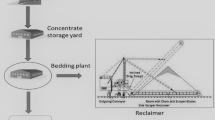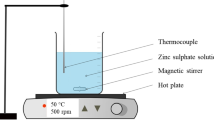Abstract
This paper presents a mathematical model for solving the blending composition problem used in the zinc smelting process. The model proposes an objective function maximizing profit in terms of the total income from the sale of zinc on the market and the cost of producing zinc. In addition to the constraints contained in the basic mathematical model, the constraints, which are in accordance with the specific production process of zinc and environmental requirements, are developed. This paper proposes a model that can align three contradictory demands (technological, economic, and environmental) present in zinc production. The results, obtained by numerical experiments, confirm the assumption that it is possible to assemble such an optimal batch that will “reconcile” all contradictory demands. This model can be applied to other similar processes of production with minor changes.


Similar content being viewed by others
References
Lineberry, G.T., & Gillenwater, E. L. (1987). Linear programming to improve raw coal blending: a new twist to an old tool. Coal Preparation, 4(3-4), 227–239. doi:10.80/07349348708945534.
Van Drew, S.L., & Maurer, R.A. (1987). Coal preparation and blending technique based on linear programming. Chapter 11 - Mining engineering and operations. In Mineral Resource Management by Personal Computer, pp. 89–94. Society of Mining Engineerings of AIME. Lettleton, CO.
Liu, C.M., & Sherali, H.D. (2000). A coal shipping and blending problem for an electric utility company. Omega–International Journal of Management Science, 28(4), 433—444. doi:10.1016/S0305-04839900067-5.
Kim, J., & Lewis, R.L. (1987). A large scale linear programming application to least cost charging for foundry melting operations. American Foundrymens. Society Transactions, 95, 735–744.
Ashayeri, J., van Eijs, A.G.M., & Nederstigt, P. (1994). Blending modelling in a process manufacturing: a case study. European Journal of Operational Research, 72(3), 460–468. doi:10.1016/0377-22179490416-2.
Nikolić, Dj., Jovanović, I., Mihajlović, I., & Živković, Ž (2009). Multi-criteria ranking of copper concentrates according to their quality—an element of environmental management in the vicinity of copper Smelting complex in Bor, Serbia. Journal of Environmental Management, 91(2), 509–515. doi:10.1016/j.jenvman.2009.09.019.
Saramak, D., Tumidajski, T., & Skorupska, B. (2010). Technological and economic strategies for the optimization of Polish electrolytic copper production plants. Minerals Engineering, 23(10), 757–764. doi:10.1016/j.mineng.2010.05.013.
Saramak, D. (2011). Optimal production of electrolytic copper determined by the concentration and distribution of copper concentrates to smelters on the example of KGHM. Archives of Metallurgy and Materials, 56(3), 619–626. doi:10.2478/v10172-011-0067-z.
Jovanović, I., & Stanimirović, P. (2012). A blending problem in copper production. Environmental Modeling and Assessment, 17(5), 495–503. doi:10.1007/s10666-012-9309-3.
Jovanović, I., Stanimirović, P., & Živković, Ž (2013). Environmental and economic criteria in ranking of copper concentrates. Environmental Modeling and Assessment, 8(1), 73–83. doi:10.1007/s10666-012-9327-1.
Savić, M., Mihajlović, I., & Živković, Ž (2013). An ANFIS-based air quality model for prediction of SO2 concentration in urban area. Serbian Journal of Management, 8(1), 25–38. doi:10.2139/ssrn.2257533.
Kalina, J. (2013). Highly robust methods in data mining. Serbian Journal of Management, 8, 9–24. doi:10.5937/sjm8-3226.
Djordjević, P., Mihajlović, I., & Živković, Ž (2010). Comparasion of linear and nonlinear statistics metods applied in industrial process modeling procedure. Serbian Journal of Management, 5(2), 189–198.
Djurić, I., Djordjević, P., Mihajlović, I., Nikolić, Dj., & Živković, Ž (2010). Prediction of Al2O3 leaching recovery in the Bayer process using statistical multilinear regression analysis. Journal Of Mining And Metallurgy Section B: Metallurgy, 46(2B), 161–169. doi:10.2298/JMMB1002161D.
Queiroz, C.A.R., Carvalho, R.J., & Moura, F.J. (2005). Oxidation of zinc sulphide concentrate in a fluidized bed reactor, Part.2. The influence of experimental variables and kinetics. Brazilian Journal of Chemical Engineering, 22(1), 127–133. doi:10.1590/S0104-66322005000100013.
Balarini, J.C., de Oliveira Polli, L., Miranda, T.L.S., de Castro, R.M.Z., & Salum, A. (2008). Importance of roasted sulphide concentrates characterization in the hydrometallurgical extraction of zinc. Minerals Enginering, 21(1), 100–110. doi:10.1016/j.mineng.2007.10.00.
WHO–World Health Organization. (2001). Air quality guidelines for Europe (2nd edition WHO regional publications). Copenhagen: Regional Office for Europe.
EU, 1999/30/CE 1999. Council Directive relating to limit values for sulphur dioxide, nitrogen dioxide and oxide of nitrogen, particulate matter and lead in ambient air. The Council of the European Union.
EU, 2004/107/CE 2004. Council Directive relating to arsenic, cadmium, mercury, nickel and polycyclic aromatic hydrocarbons in ambient air. The Council of the European Union.
Habachi, F. (1998). Principles of extractive metallurgy. Vol. 4, Amalgam Electrometallurgy Metallurgie Extractive Quebec. Canada: Quebec.
Habachi, F. (2009). Recent trends in extractive metallurgy. Journal of Mining and Metallurgy Section B: Metallurgy, 45B(1), 1–13. doi:10.2298/JMMB0901001H.
Dutrizac, J.E. (2010). Comparative rates of precipitation of ammonium jarosite and sodium jarosite in ferric sulphate–sulphuric acid media. The Canadian Metallurgical Quarterly, 49(2), 121– 130.
Chen, T.T., & Dutrizac, J.E. (2004). Mineralogical changes occurring during the fluid-bed roasting of zinc sulfide concentrates. Journal of Metals / JOM, 56(12), 46–51. doi:10.1007/s11837-004-0235-y.
Dimitrov, R.I., Moldovanska, N., Bonev, I.K. & Živković, Ž. (2000). Oxidation of marmatite. Thermochimica Acta, 362(1-2), 145–151. doi:10.1016/S0040-6031(00)00582-7.
Wolfram, S. (2003). The Mathematica Book, 5th edn. Champaign: Wolfram Media/Cambridge University Press.
Acknowledgments
The authors gratefully acknowledge support from the Research Projects TR34023, financed by The Ministry of Education and Science of the Republic of Serbia.
Author information
Authors and Affiliations
Corresponding author
Additional information
The results shown in this paper are part of the research of the TR34023 project, financed by The Ministry of Education and Science of the Republic of Serbia.
Appendix: Implementation in MATHEMATICA
Appendix: Implementation in MATHEMATICA
This section describes the mathematica code for computing values max F(x). List P defines the contents of all 19 components contained in 10 separate concentrates. The 19th concentrate component is the “miscellaneous” group.

The initial data are defined as follows:

The objective function is defined as the following:

Constraints are defined as follows:

When you have defined all the necessary parameters, it is possible to calculate the value max F(x). To obtain an optimal solution for the first numerical experiment, it is necessary to apply step A. For the second numerical experiment, step B is applied, and step C for the third.
Step A. Calculation for the first numerical experiment (only Zn):

Step B. Calculation for the second numerical experiment (Zn + S + As):

Step C. Calculation for the third numerical experiment (Zn + all elements):

Rights and permissions
About this article
Cite this article
Jovanović, I., Savić, M., Živković, Ž. et al. An Linear Programming Model for Batch Optimization in the Ecological Zinc Production. Environ Model Assess 21, 455–465 (2016). https://doi.org/10.1007/s10666-015-9485-z
Received:
Accepted:
Published:
Issue Date:
DOI: https://doi.org/10.1007/s10666-015-9485-z




